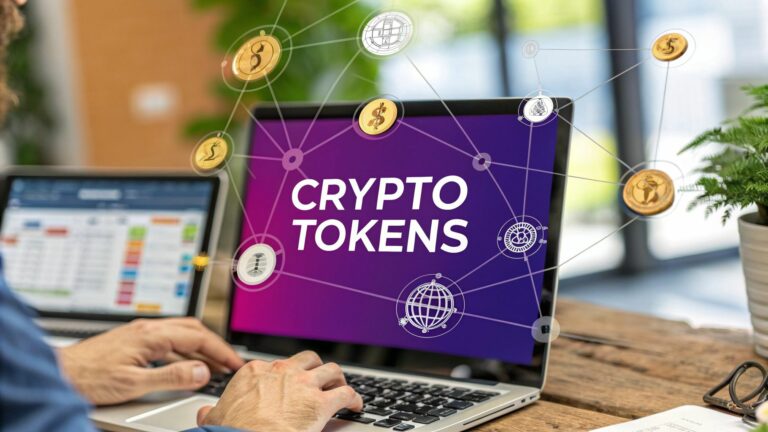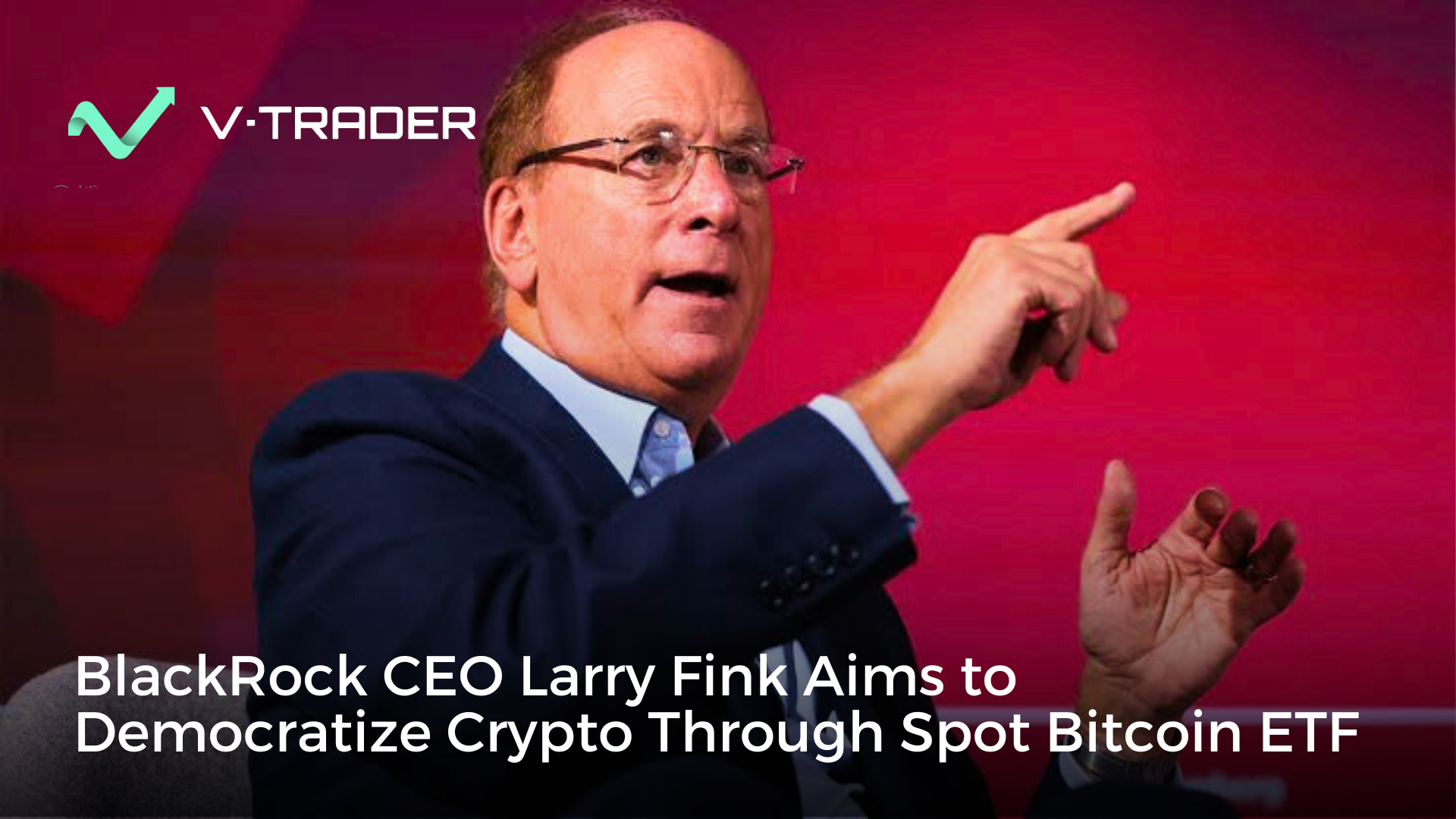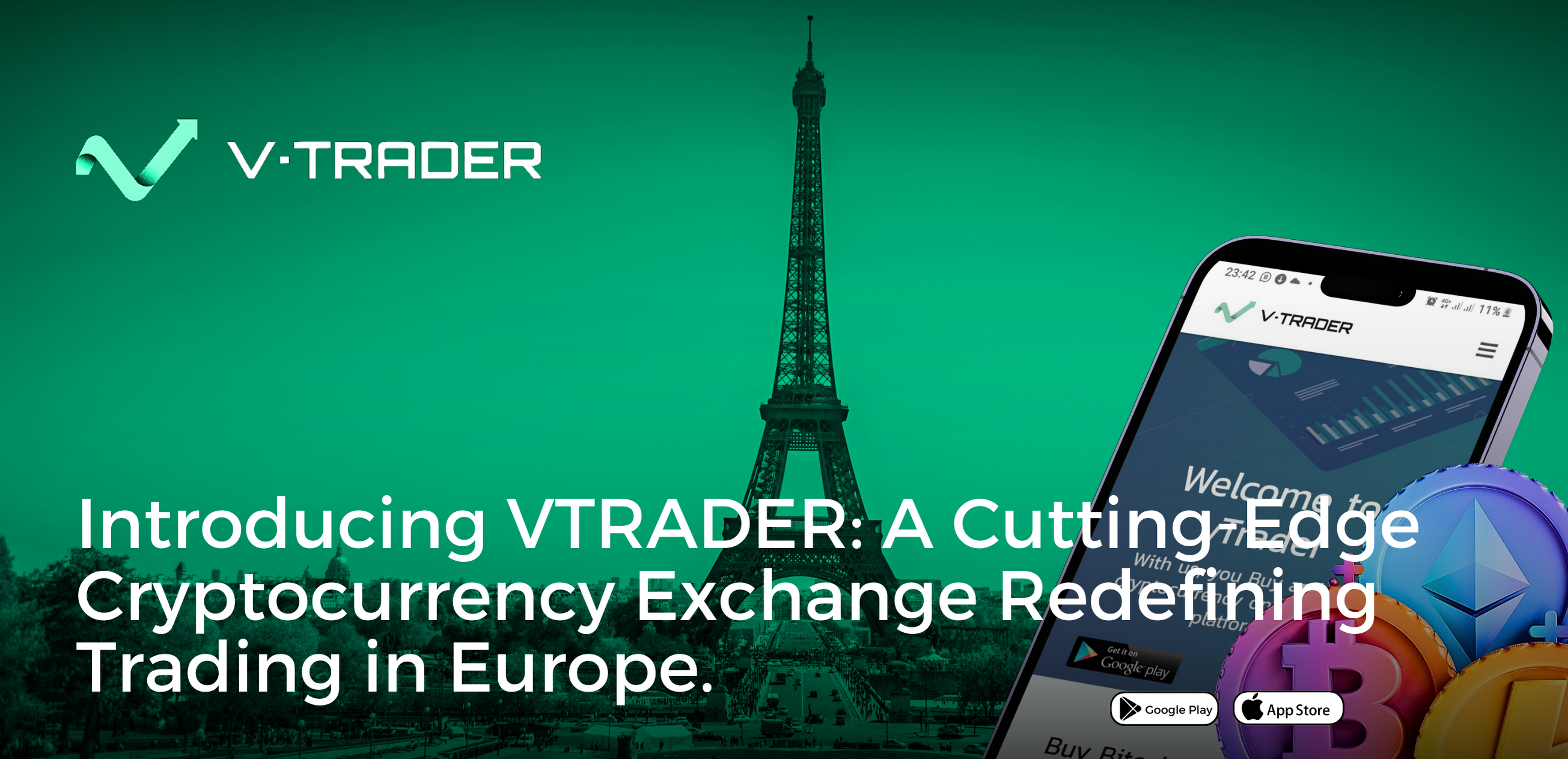When you dive into crypto, you'll hear the word "token" thrown around a lot. So, what exactly is it? Think of a token as a digital asset that's built on top of an existing blockchain. It’s a lot like how an app runs on your phone's operating system—the app doesn't need its own OS, it just uses the one that's already there.
Unlike cryptocurrencies like Bitcoin, which have their own dedicated blockchains, tokens piggyback on the security and infrastructure of established networks like Ethereum. This is a game-changer for developers.
Unpacking The Role Of Crypto Tokens
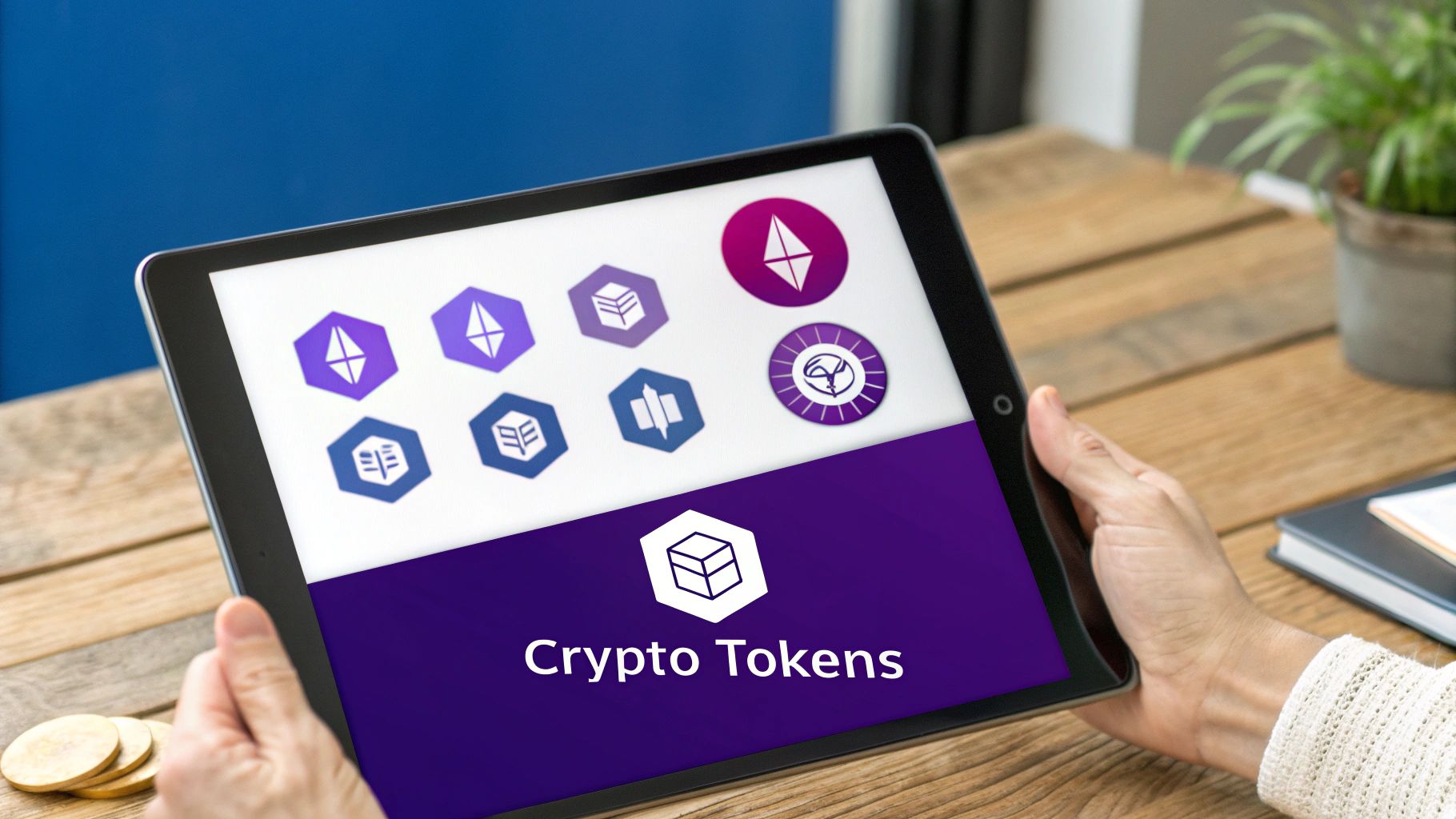
To really get what tokens are all about, let’s stick with a simple analogy. Imagine a blockchain like Ethereum as a massive, public digital ledger—it's the foundational platform. Developers can build their applications right on top of it without the headache and expense of creating a whole new blockchain from the ground up.
These applications, or dApps, need their own internal currency or unit of value to function. That's where tokens step in. They are custom digital units created by projects to work inside their specific ecosystem, allowing creators to focus on their unique vision instead of getting bogged down in complex network maintenance.
The Purpose of a Token
At their core, tokens represent assets or utility on a blockchain. They can be anything from a right to vote on a project's future to a key that unlocks features in an app. Since Ethereum introduced the ERC-20 token standard back in 2015, the number of tokens has absolutely exploded, with tens of thousands circulating globally by the mid-2020s.
This incredible versatility is what makes tokens so powerful. They can represent almost anything of value:
- Governance: A stake in a project that gives holders voting rights on important decisions.
- Utility: Access to a service, like a key to unlock features in a decentralized application.
- In-Platform Currency: A store of value that works like money within a specific game or platform.
- Digital Collectibles: Ownership of a unique item, like digital art or collectibles (these are known as NFTs).
Crypto Tokens vs Coins At A Glance
One of the biggest hurdles for newcomers is telling the difference between a "token" and a "coin." They might seem interchangeable, but they are fundamentally different in their structure and purpose. Simply put, a coin is native to its own blockchain, while a token is not. We're proud to support both on our exchange, fulfilling our mission at https://www.vtrader.io/en-us/about to provide broad market access.
This table breaks down the main distinctions at a glance.
| Attribute | Cryptocurrency Coins (e.g., Bitcoin, Ether) | Cryptocurrency Tokens (e.g., UNI, LINK, APE) |
|---|---|---|
| Blockchain | Operate on their own independent, native blockchain. | Built on top of an existing blockchain (e.g., Ethereum, Solana). |
| Primary Use | Primarily used as a store of value or medium of exchange. | Serve a specific purpose within a project or application (utility, governance). |
| Creation | Created through a process called mining or validation. | Issued through a smart contract on an existing platform. |
| Function | Act as the "gas" to pay for network transaction fees. | Leverage the host blockchain's security and infrastructure. |
Understanding this key difference is crucial. Coins power and secure their own networks, while tokens are built to add specific functions and value within those networks.
The Critical Difference Between Coins and Tokens
In the crypto world, you'll hear the words "coin" and "token" thrown around like they mean the same thing. They don't. Getting the distinction isn't just about sounding smart—it's about understanding the very engine that drives most of the innovation in digital assets.
The whole thing boils down to one simple question: does it have its own blockchain?
A cryptocurrency coin, like Bitcoin (BTC) or Ether (ETH), is the native currency of its own unique blockchain. Think of the blockchain as a country and the coin as its official currency. You can’t operate inside that country without using its money. It’s what you use to pay for everything—transaction fees (often called "gas"), security, and rewarding the people who keep the network running.
The Landlord and Tenant Analogy
So, what are tokens in cryptocurrency? Let’s stick with the country analogy. If the blockchain is a digital country, a token is like a business that opens up shop there. Instead of building its own roads, power grid, and government from scratch, it just rents a storefront and uses the country's reliable infrastructure.
It breaks down like this:
- The Blockchain (e.g., Ethereum) is the Landlord: It provides the foundation—the security, the stability, the rules of the road. It’s the established infrastructure.
- The Token Project (e.g., Uniswap's UNI) is the Tenant: It builds its unique business on the landlord’s property. To operate, the tenant pays "rent" in the form of gas fees using the landlord's native coin (in this case, Ether).
This landlord-tenant relationship is why crypto moves so fast. It allows anyone with a great idea to launch a new project without having to build an entire blockchain from the ground up.
A project can issue a token via a smart contract in a matter of hours, leveraging the billions of dollars of security provided by a network like Ethereum, without spending a cent on building a new blockchain.
It's just infinitely easier and cheaper to be a tenant than to build a whole new country. This is exactly why you see thousands upon thousands of tokens but only a fraction of that number in coins.
Why This Relationship Fuels Innovation
This setup creates a powerful dynamic where developers can zero in on what they do best: building cool stuff. They don't have to sweat the massive technical and financial headache of maintaining a secure network. This has unleashed a tidal wave of creativity.
Just look at what’s been built:
- Decentralized Finance (DeFi): Projects like Aave and Compound launched tokens for lending and borrowing services, all running safely on Ethereum's backbone.
- Gaming: The APE token for the Otherside metaverse lives on Ethereum, acting as an in-game currency without needing its own separate blockchain.
- Real-World Assets: Companies are now tokenizing things like real estate and stocks, making them tradable on existing blockchains and accessible to a global audience.
Every one of these projects piggybacks on the security of a host blockchain while carving out its own niche. By acting as tenants, token creators can build entire digital economies on proven, battle-tested foundations. It dramatically lowers the barrier to entry and keeps the entire space buzzing with new ideas. That’s the critical difference that makes the world of tokens so dynamic.
The Four Main Types of Crypto Tokens

The word "token" gets thrown around a lot, but it’s a massive umbrella for all kinds of digital assets. Each one is built for a very specific job. To really get your head around what tokens are in cryptocurrency, you need to split them into a few key categories based on what they actually do.
While the space is always creating new hybrids, almost every token you'll come across fits into one of four main camps.
Looking at them this way gives you a simple framework. It helps you cut through the noise and figure out what a project is really about and what value its token is supposed to bring to the table. Let's break down these four types.
Utility Tokens: The Keys to a Service
The most common flavor you'll find is the utility token. The easiest way to think of one is like a token for an arcade. You can't buy a piece of the arcade company with it, but you absolutely need it to play the games inside.
In the crypto world, utility tokens are the digital keys that get you into a specific product or service on a decentralized app (dApp). They’re meant to be the internal currency for an ecosystem—something you use, not just something you hold hoping the price goes up.
- Analogy: An arcade token.
- Purpose: To grant access to a platform's features.
- Example: Basic Attention Token (BAT) is a classic example. If you use the Brave browser, you can earn BAT for watching ads that respect your privacy. Then, you can turn around and use those same tokens to tip your favorite content creators.
Security Tokens: Digital Stock Certificates
Next up are security tokens, and these are a completely different animal from utility tokens, especially when it comes to rules and regulations. A security token is basically a digital wrapper for ownership in a traditional financial asset. Think stocks, bonds, or even a sliver of ownership in a high-rise apartment building, but on the blockchain.
Because they represent a real investment in a business with an expectation of profit, security tokens fall under heavy financial regulations. Their real power is making things that are normally hard to sell—like a piece of fine art or a stake in a startup—incredibly easy to trade on a global market that never closes.
- Analogy: A stock certificate for a company.
- Purpose: To represent ownership of a tradable, real-world asset.
- Example: tZERO (TZROP) is a token that gives holders an equity stake in the tZERO platform itself, which is a marketplace for other security tokens. Owners might even get a cut of the company’s revenue.
The global crypto market, which is made up of both native coins and all these different tokens, has seen explosive growth, hovering around a $2.76 trillion market cap as of April 2025. Tokens are a massive slice of that pie, with an estimated 6.8% of the world's population now owning some form of digital asset.
Governance Tokens: Your Vote in a Project
As decentralized platforms get bigger, they need a way for the community to make decisions together. That's where governance tokens step in. Holding these tokens gives you a real say in where a project is headed, almost like a shareholder getting to vote at an annual company meeting.
Typically, one token equals one vote. This lets the whole community of holders propose and vote on everything from changing the platform’s fee structure to approving major tech upgrades. It’s a model that shifts power from a central team to the actual users. For breaking news on decentralized governance and more, you can check out the vTrader news hub for the latest updates.
Governance tokens are a powerful mechanism for community-led development. They align the incentives of the users with the long-term success of the protocol, creating a self-sustaining ecosystem.
- Analogy: A seat on a board of directors.
- Purpose: To grant voting rights on a project's development and rules.
- Example: Uniswap (UNI) is one of the biggest decentralized exchanges out there. If you hold UNI tokens, you can vote on proposals that dictate how the platform evolves, like deciding how to spend treasury funds or what new features to build next.
Non-Fungible Tokens: Unique Digital Ownership
Finally, we have Non-Fungible Tokens (NFTs). While all the other tokens we've talked about are "fungible"—meaning one is the same as another, just like one dollar bill is the same as any other—NFTs are each one-of-a-kind. They can't be replaced one-for-one. Each NFT has a unique digital fingerprint on the blockchain that proves it's the real deal and who owns it.
This uniqueness makes them the perfect tool for representing one-of-a-kind items, both digital and physical.
- Analogy: A signed piece of art or a deed to a house.
- Purpose: To prove ownership of a unique digital or physical asset.
- Example: The Bored Ape Yacht Club (BAYC) is a collection of 10,000 unique digital art pieces. Each ape is an NFT that acts as both a collectible and a membership pass to an exclusive club.
How Token Standards Like ERC-20 Work
If tokens are the apps running on a blockchain's operating system, then token standards are the developer guidelines—the rulebook that makes sure every app plays nicely. They’re a common set of rules dictating how a token must behave. This universal language is exactly why your tokens can appear in a MetaMask wallet or be traded on an exchange without a hitch.
Imagine a world without them. It would be pure chaos. Every new token would demand custom coding for every single wallet, exchange, and app that wanted to support it. Instead, these standards provide a blueprint, getting everyone on the same page technically.
ERC-20: The Blueprint for Digital Money
The most recognized and widely used token standard is ERC-20 on the Ethereum blockchain. Think of it as the go-to template for creating fungible tokens—assets where each one is identical and can be swapped for another, just like a dollar bill. One UNI token is worth the exact same as any other UNI token.
This interchangeability makes ERC-20 the perfect foundation for anything meant to act like money, from utility tokens to governance tokens and the assets underpinning decentralized finance (DeFi). The standard mandates a few basic functions:
- Total Supply: Defines the total number of tokens that will ever exist.
- Balance Of: Checks how many tokens a particular address holds.
- Transfer: Allows tokens to be sent from one wallet to another.
This simple but powerful framework ensures any ERC-20 token works seamlessly with any platform that supports the standard. It’s like having a universal size for AA batteries; you know it will fit any compatible device, no matter the brand.
To really get a handle on token fundamentals, the graphic below breaks down a few of the key metrics traders use to size them up.
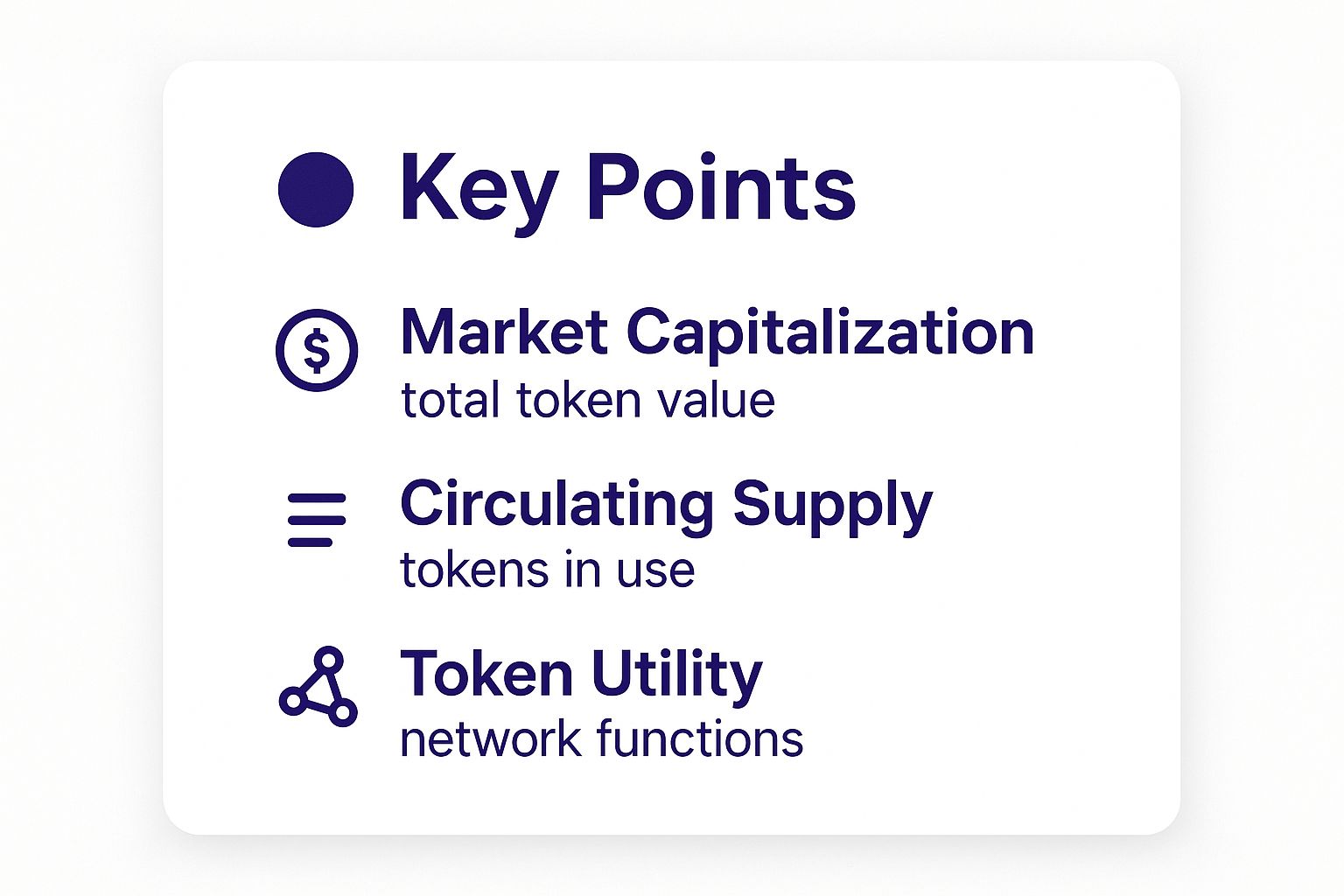
These three data points—market cap, circulating supply, and utility—offer a quick but valuable snapshot of a token's economic health and its role within its ecosystem.
ERC-721: Creating Unique Digital Collectibles
ERC-20 is fantastic for identical units, but what about assets that are truly one-of-a-kind? That’s where the ERC-721 standard enters the picture. It's the technical backbone for Non-Fungible Tokens (NFTs). Each token created with this standard is unique, carrying its own distinct identity and value.
An ERC-20 token is like a general admission ticket to a concert—any ticket will get you in the door. An ERC-721 token is like a ticket with a specific seat number; it's unique and can't be swapped for another.
This is the standard that fuels the world of digital art, collectibles, and virtual land. Every ERC-721 token has a unique tokenId, essentially a digital serial number that sets it apart from all others. This is what makes it possible to prove you own a specific, non-interchangeable digital item on the blockchain.
Popular Token Standards Explained
The world of tokens is constantly evolving, with new standards popping up to solve new problems. While ERC-20 and ERC-721 are the heavyweights, several others have carved out important niches. Here’s a quick rundown of the major players.
| Standard | Key Feature | Primary Use Case | Example |
|---|---|---|---|
| ERC-20 | Fungible (interchangeable) | Currencies, utility tokens | Uniswap (UNI), Chainlink (LINK) |
| ERC-721 | Non-Fungible (unique) | Digital art, collectibles | CryptoPunks, Bored Ape Yacht Club |
| ERC-1155 | Multi-Token (fungible & non-fungible in one contract) | Blockchain gaming, complex collectibles | Enjin Coin (ENJ) |
| BEP-20 | ERC-20 equivalent on BNB Chain | DeFi, dApps on BNB Chain | PancakeSwap (CAKE) |
| SPL | High-performance tokens | High-speed DeFi, Memecoins on Solana | Bonk (BONK) |
Each of these standards was built with a specific purpose in mind, from creating simple digital currencies to managing complex in-game economies. Their existence is a testament to how flexible and adaptive blockchain technology has become.
How Tokens Are Created and Distributed
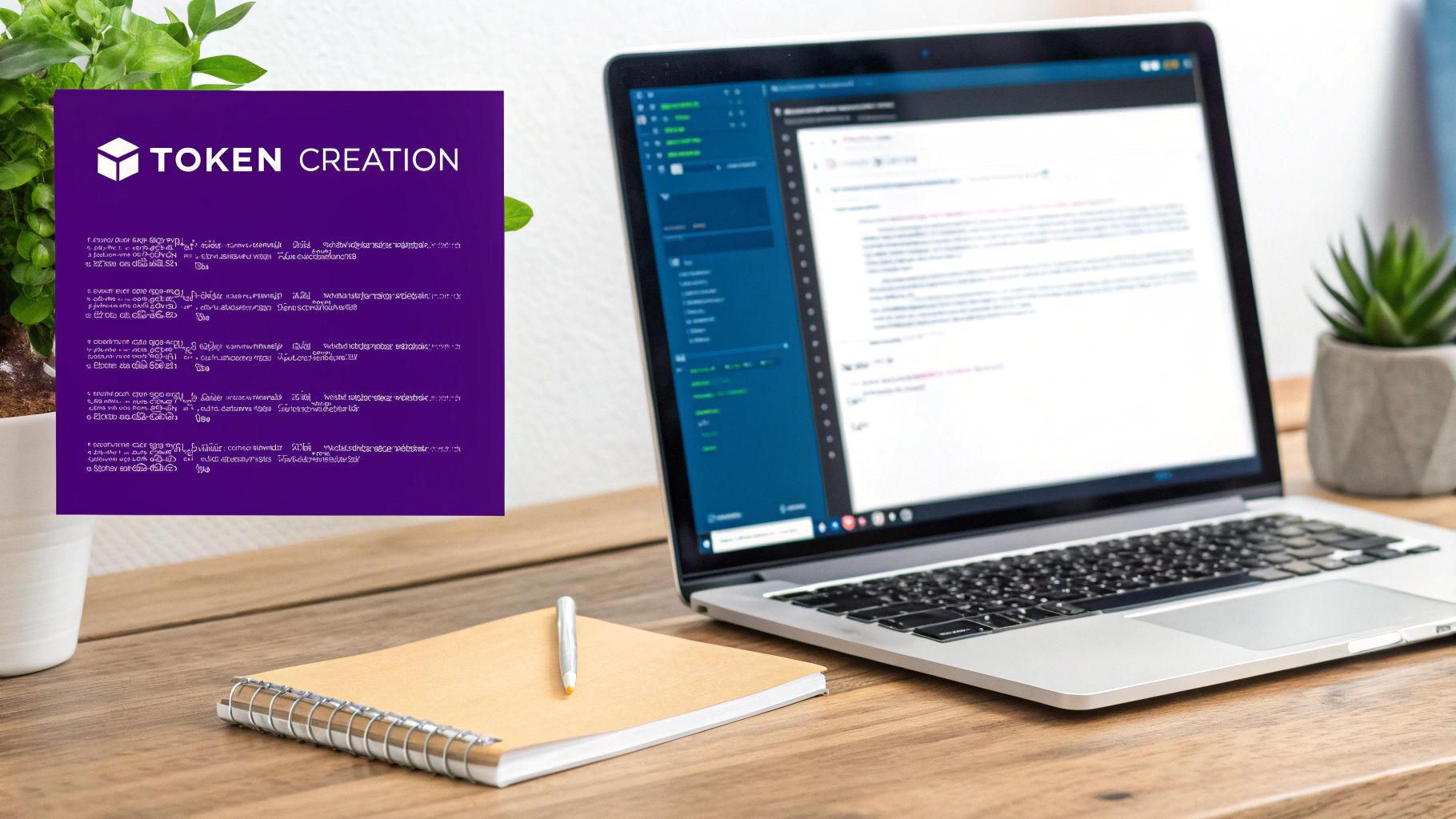
New cryptocurrency tokens don't just materialize out of nowhere. They’re brought to life through a very deliberate creation process before being strategically released to the public. This journey, from a simple idea to a tradable digital asset, is one of the most critical stages for any new crypto project.
It all starts with a process called minting, which is managed by a smart contract. Developers write the code that sets the token's ground rules—things like its name, symbol, total supply, and the logic for how it can be moved. Once this smart contract goes live on a blockchain like Ethereum, it essentially becomes an automated token factory, minting new tokens precisely as it was programmed to.
But creating the tokens is just the first step. The real challenge is getting them into the hands of a community and potential investors. Over the years, several different distribution models have popped up, each with its own benefits and drawbacks.
Initial Coin Offerings (ICOs)
The classic method that put token launches on the map is the Initial Coin Offering (ICO). You can think of it as the crypto world's answer to an Initial Public Offering (IPO) in the stock market. In an ICO, a project sells a chunk of its newly created tokens directly to the public to raise money for development.
ICOs became legendary during the 2017 crypto boom, a period when projects raised billions of dollars seemingly overnight. But that wild west environment also attracted a flood of scams and heavy regulatory scrutiny, which is why you don't see as many legitimate projects using this model today.
Modern Distribution Methods
As the crypto space matured, newer and more transparent ways to distribute tokens have taken center stage. These modern approaches are designed to foster fairer launches and build passionate communities right from the get-go.
Here are a few of the most common strategies you'll see now:
- Initial DEX Offering (IDO): Instead of a centralized sale, tokens are launched directly on a Decentralized Exchange (DEX). This approach enables immediate trading and price discovery through an automated liquidity pool, opening up access to a wider audience.
- Airdrops: Projects often give away tokens for free to the wallet addresses of existing blockchain users. This is usually a reward for loyalty to a parent ecosystem or a clever marketing tactic to generate buzz and onboard a new user base.
- Staking Rewards: Many projects reserve a portion of their tokens to reward users who help secure the network through staking. If you want to dive deeper into how that works, check out the fundamentals of crypto staking in our detailed guide.
Choosing a distribution method like an IDO or an airdrop allows a project to put community building ahead of pure fundraising. This often results in a more dedicated user base that's genuinely invested in the ecosystem's long-term success.
Ultimately, how a token is created and distributed says a lot about a project's intentions. Whether it’s through a massive public sale or a community-focused airdrop, the launch strategy lays the entire economic foundation for the token and its future.
Navigating Token Risks and Regulations
While the world of crypto tokens is full of exciting possibilities, it's also a minefield of significant risks and a regulatory environment that’s constantly changing. Understanding these challenges isn’t just good advice—it’s essential for anyone looking to step into this market safely.
Your first line of defense is being aware of the dangers, which range from technical vulnerabilities to outright scams.
One of the biggest threats comes from the very code that brings tokens to life. A single bug or exploit in a smart contract can trigger a catastrophic loss of funds, often with no way for investors to get their money back. Beyond these technical flaws, the market is also teeming with malicious schemes designed to catch unwary participants off guard.
Common Dangers in the Token Market
The semi-anonymous nature of many crypto projects creates fertile ground for certain types of scams. It's crucial to learn the warning signs to protect your capital. Before you engage with any platform, always take the time to review its policies, like our own terms and conditions, to understand your rights and the platform's responsibilities.
Here are a few of the major risks to keep on your radar:
- Rug Pulls: This is a depressingly common scam where developers launch a token, convince people to invest to build up its liquidity, and then abruptly pull all the funds. They vanish, leaving investors holding worthless tokens.
- Extreme Volatility: Token prices can swing wildly based on hype, social media chatter, and pure market sentiment. It’s not unusual for a token to lose over 90% of its value in a flash, especially if it has no real-world use case.
- Phishing Scams: Scammers build fake websites or blast out deceptive emails to trick you into connecting your wallet. Once you do, they can drain your assets. Always double-check URLs and be highly skeptical of unsolicited offers.
The Evolving Regulatory Landscape
On top of market risks, government oversight is a huge factor shaping the future of tokens. Regulators around the globe are still trying to figure out how to classify and manage these new digital assets, creating a complex and uncertain environment for projects and investors alike.
Tokens have introduced new legal and technological puzzles that government agencies are now scrambling to solve. Regulatory bodies like the U.S. Securities and Exchange Commission (SEC) have ramped up their scrutiny, particularly on ICOs and staking services, which they often view as unregistered securities. A key example was in February 2023, when the exchange Kraken paid a $30 million settlement with the SEC over its staking products. As governments continue to issue new rules, the landscape for digital assets will keep shifting.
The lack of clear, consistent regulation means the rules of the game can change overnight. What’s allowed today might be restricted tomorrow, making long-term planning a real challenge.
Navigating this space demands constant vigilance and a serious commitment to doing your own research. While understanding these risks doesn't guarantee success, it absolutely equips you to make smarter, more informed decisions in a very high-stakes market.
Frequently Asked Questions About Crypto Tokens
Even after you get the hang of the basics, a few practical questions always pop up. Let's tackle some of the most common ones to connect the dots between the concepts and the real world.
We'll dig into why tokenization is such a big deal, how you can actually get your hands on tokens, and the cold, hard truth about their potential as an investment.
What Is The Main Purpose of Tokenization?
At its core, tokenization is all about taking something of value—whether physical or digital—and representing it as a digital token on a blockchain. This simple act makes the asset ridiculously easy to divide up, trade, and send to anyone, anywhere, with almost no hassle.
Think about a massive, multi-million-dollar office building. Tokenizing it allows for fractional ownership. Instead of one person needing to cough up millions, hundreds of smaller investors can buy tradable "shares" of the property. It unlocks liquidity and opens up high-value assets to a much bigger crowd.
How Can I Buy Cryptocurrency Tokens?
Getting into tokens is probably easier than you think. There are really two main routes, and which one you choose just depends on your comfort level with crypto.
-
Centralized Exchanges (CEX): Think of platforms like Coinbase or Binance. They work a lot like a normal brokerage account, letting you buy tokens with regular money (like USD or EUR) from your bank or debit card. For most beginners, this is the simplest starting point.
-
Decentralized Exchanges (DEX): Platforms like Uniswap cut out the middleman for a more direct, peer-to-peer trading experience. To use a DEX, you'll need your own crypto wallet (like MetaMask) and some of the blockchain's native coin, like Ether, to swap for other tokens and cover transaction fees.
If you have more specific questions about how certain platforms work, you can find a ton of info by checking out our comprehensive crypto FAQ page.
Are All Crypto Tokens a Good Investment?
Definitely not. And it’s crucial to get this straight: the vast majority of crypto tokens are incredibly high-risk, speculative bets. A token's value is almost entirely tied to the success, adoption, and usefulness of the project behind it.
A huge number of projects simply fail. Scams are everywhere, and even legitimate tokens can swing wildly in price. Before you even think about investing, you absolutely must "Do Your Own Research" (DYOR).
This means you have to dig deep. Read the project's whitepaper, check out the team's experience, see if they have a real community, and understand its tokenomics—the model that dictates the token's supply and demand. Always go in with the assumption that you could lose everything you put in, because that is a very real possibility.
Ready to explore the world of tokens with zero trading fees? At vTrader, we empower you to trade Bitcoin, Ethereum, and over 30 altcoins without commissions. Get started today and claim your $10 sign-up bonus. Join vTrader now.

Steve Gregory is a lawyer in the United States who specializes in licensing for cryptocurrency companies and products. Steve began his career as an attorney in 2015 but made the switch to working in cryptocurrency full time shortly after joining the original team at Gemini Trust Company, an early cryptocurrency exchange based in New York City. Steve then joined CEX.io and was able to launch their regulated US-based cryptocurrency. Steve then went on to become the CEO at currency.com when he ran for four years and was able to lead currency.com to being fully acquired in 2025.
